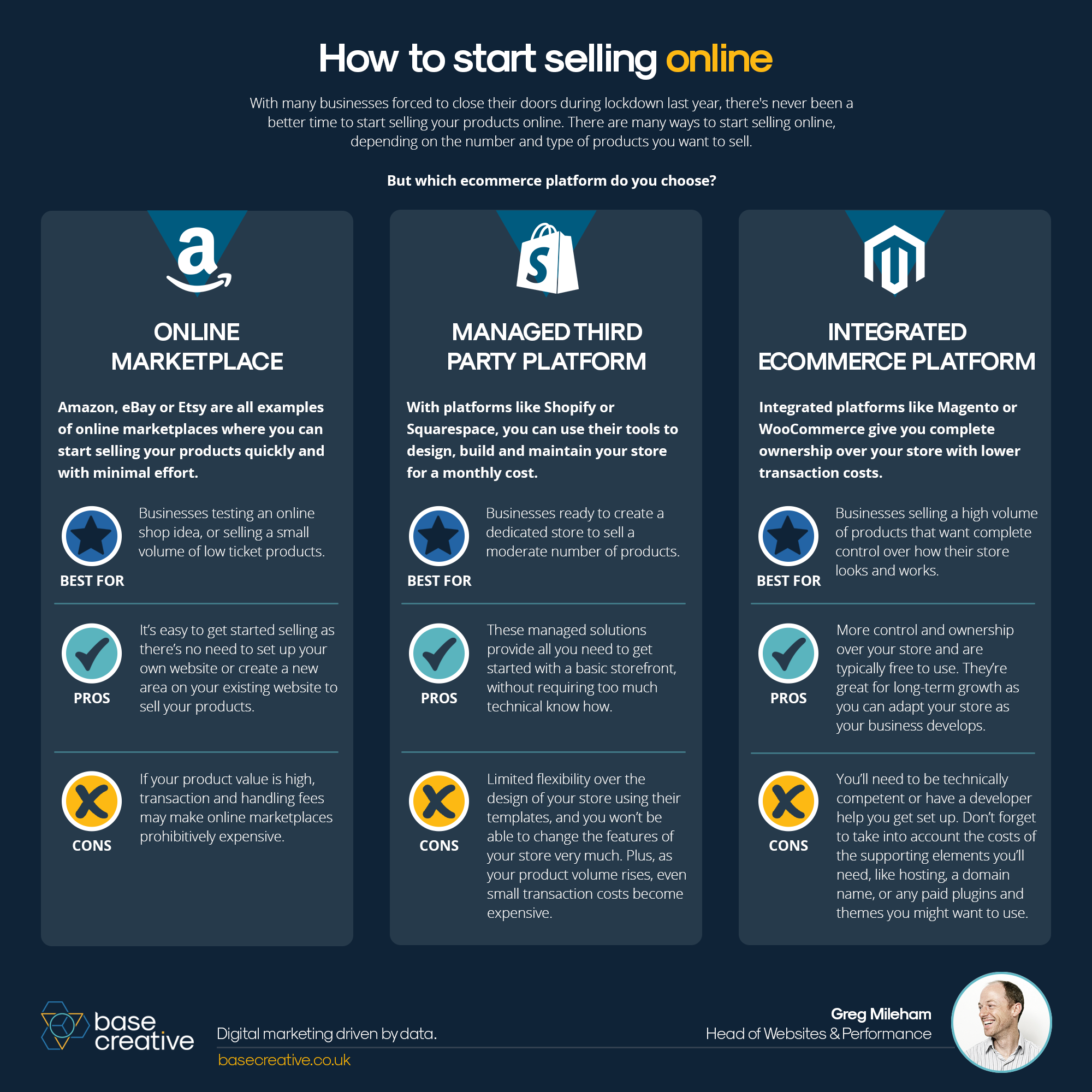Ecommerce Analytics Guide - All You Need To Know
E-commerce business analysts include metrics relevant to the entire customer journey from discovery, to transformation, conversion, ultimately retention and advocacy. Why do you need eCommerce analytics?
- By David Nguyen
- 1135 views
- 0 reply

David Nguyen
Founder & CEO, Cmsmart Ecommerce (a division of Netbase JSC)
With over 20 years of experience in business strategy and ecommerce technolo David Nguyen
Founder & CEO, Cmsmart Ecommerce (a division of Netbase JSC)
With over 20 years of experience in business strategy and ecommerce technology, David Nguyen has empowered hundreds of online retailers around the world to scale smarter and faster. As the visionary behind Cmsmart, he has driven the development of personalization solutions and product-customization tools that deepen customer engagement and boost average order values. His commitment to creativity, practical strategy and results-driven outcomes has earned Cmsmart a reputation as a trusted partner for small, medium and enterprise-level ecommerce brands.
Contact Me via WhatsApp: https://wa.me/84937869689
Email: [email protected]
Let’s talk about how your ecommerce store can grow.
If you're ready to transform your store with tailored solutions that drive engagement and revenue, send me a message on WhatsApp or email today — and our team will connect with you right away. ...
TABLE OF CONTENTS
"I Knew My Store Could Do Better...
But I Didn't Know How"
That's what one of our clients, Jessica, told us. She was running a small mug store on WooCommerce—sales were okay, but stuck.
Until she discovered personalization.
Until she discovered Cmsmart.
Fast-forward 30 days:
- ✅ Her store was redesigned with AI product options
- ✅ Customers could design their own mugs with 3D preview
- ✅ AOV jumped by 42% — and she finally felt in control
Want to learn how she did it (and how you can too)?
🎓 Join our FREE 30-Day Email Course:
"Personalize, Launch & Scale – The Smart Ecommerce Way"
You'll get:
- ✔ 1 lesson a day, straight to your inbox
- ✔ Real store examples, demos & playbooks
- ✔ No tech jargon. Just strategy that works.
Join thousands of store owners learning how to scale smarter.
🎉 You're In! Thank You!
We've received your information and you're now part of our smart ecommerce journey.
Please check your inbox – your first email from the 30-Day Course is on its way!
📩 Didn't see it? Check your spam or promotions tab and mark us as safe.
We're excited to help you personalize, launch, and scale your store – the smart way.
TABLE OF CONTENTS
Related Post
Did you know that eCommerce sales are projected to reach a staggering $8 trillion by 2027? In a world where high transaction fees and limited flexibility can cripple potential...
Imagine doubling your conversion rates simply by understanding and implementing the latest trends in eCommerce - sounds exciting, right? In a 2022 report, it was highlighted that the global...
Introduction: The Power of Custom Stickers for SMEs In today’s dynamic ecommerce landscape, custom stickers have emerged as a powerful tool for small and medium-sized enterprises (SMEs) to stand out,...
Other Usefull Contents
You can see many success stories from our customers, and you may be one of them in the future












For many businesses, e-commerce analytics gradually plays a key role in business success or failure. Because analyzing and understanding available data will help businesses understand past mistakes and find solutions, and discover new business opportunities. And instead of just making decisions based on feelings or judgment, with e-commerce analytics business owners will have a very intuitive and scientific basis for making better decisions.
Understanding the Significance of E-Commerce Analytics
E-commerce analytics is the process of collecting, aggregating, and using data related to e-commerce business activities to better understand consumer behavior and new consumer trends.
By analyzing data, you can gain insight into the factors that influence your business decisions. As a result, decisions are made more accurately, in addition, it also helps to increase revenue and reduce investment risk.
E-commerce analytics tells you where your users are coming from, how much time they've spent looking at a particular product, where they spend most of their time, and more! E-commerce business analysts include metrics relevant to the entire customer journey from discovery to transformation, conversion, and ultimately retention and advocacy.
Exploring the Diverse Spectrum of E-Commerce Analytics Categories
Website Traffic Analytics
Conversion Rate Analytics
Sales and Revenue Analytics
Customer Behavior Analytics
Customer Segmentation Analytics
Marketing Channel Analytics
Product Performance Analytics
Customer Retention and Churn Analytics
Mobile Commerce Analytics
A/B Testing and Experimentation Analytics
Unveiling the Imperative Need for E-Commerce Analytics
Measuring data is not a simple task, it requires managers to spend a lot of time and money to implement. So, the question was raised, why do businesses need to do this activity? What do they get for spending so many resources?
The basis for decision-making
You cannot operate your business based on your judgments about the market. The specific data will show you the performance of the business, market trends, and customer behavior,... From there, you will know what to do next and the ability of the business to perform. your career. Accurate decisions made based on analysis from reliable data will help you limit business risks.
Deep understanding of your customers
By using e-commerce analytics, you can better understand consumers while on your website. Information such as time on site, the actions they take, the pages they view, the products they view, and products added to the cart,... can give you a picture of your customer behavior. It is the basis for you to take follow-up business activities like recommending related products and sending cart reminder emails.
Personalize User Experience
Insights into customer behavior and preferences will allow you to better personalize the customer experience. This is also the key to helping you retain customers and increase their loyalty. You can rely on analysis of customer behavior and intent to recommend the information they need such as related products, and articles on the same topic without the need to navigate around your site
Essential Factors Under the E-Commerce Analytics Microscope
A lot of information you need to collect and analyze to serve your management activities. To make it easier, you can divide them into related groups as we divide them below.
Acquisition
Click-through rate (CTR): the percentage of users who click on a specific link, to the number of total users who view an email or social media post.
Cost per lead (CPL): the average cost of generating new business leads.
Cost per acquisition (CPA): this metric goes one step further and measures the average cost of acquiring a customer.
Customer Acquisition Cost (CAC): tells you how much you spend on bringing new customers.
Behavior
Cart abandonment rate: the percentage of users who add products to the cart but do not go to the checkout step.
Bounce rate: the percentage of users that leave immediately after viewing only one page on the website. This low rate can be due to bad user experience (Long loading time, not user-friendly, poor web design,...)
Retention
Customer lifetime value (CLV): the total amount of money a customer is expected to spend with your business during their lifetime.
Customer churn rate: the percentage of customers your company has lost during a given period. It is the opposite of the customer retention rate.
Customer retention rate: the percentage of existing customers who continue to engage with your brand after a given period.
Returning customer rate refers to the number of customers who’ve made more than one purchase with you.
Conversions
Conversion rate: the percentage of people who perform conversion actions such as leaving information, making a purchase, etc.
Value per visit: The average value generated from each visit. Calculated by dividing the total value by the total number of visits.
Cost per Conversion: The cost you pay for each conversion.
Performance metrics
Number of purchases: the number of orders completed over a period of time.
Revenue: The total amount of money the business collects from transactions over a period of time.
Profit: the amount of money that the business keeps after paying all expenses.
Average Order Value (AOV): the average amount of money spent when a user buys something from your e-commerce website and other channels.
Indispensable Tools for E-Commerce Analytics Mastery
Google Analytics
Google Analytics is a valuable ally in the e-commerce war for consumer money. The detailed information it provides contains a lot of information about your website, your visitors, and where they come from. All of this information can be used to find new customers and increase conversions.
You can't bypass google analytics for your e-commerce store. It's free, easy to use, and with Google's free demo account, you can use the tool before deploying it on your website. Google Analytics also comes with a search dashboard tool, making it a great package for e-commerce entrepreneurs. Google Analytics can help you drill down into richer metrics that can be used to make decisions in marketing your business. Here’s what you can look out for:
Free tool
Custom graphs and reports
Enhanced eCommerce analytics
Customer lifetime value
Conversions
Customer Personas
Why do you need Google Analytics? If you own an actual storefront, you are likely to see your customers. You can see their habits firsthand and talk to them. Without e-commerce analytics and related KPIs, websites leave you blind to a lot of the visitor and customer information you often see.
With Google Analytics, you can track all of your online traffic sources. Understanding where your website traffic is coming from is crucial in running an online business. Installing Google Analytics right from the start of a new website is essential to start collecting traffic data. Identifying the different traffic sources and understanding why and how much traffic is appearing on your website allows you to track the benefits of your strategies.
Traffic source and channel analysis reports can be accessed in Google Analytics Conversions. Combining a user's location data like city or country with traffic data helps you understand where your users are mostly coming from.
Google Search Console
Indeed, the first step to helping people find and browse an e-commerce site is “clearly publish all the products for sale” either in-store or online or in both places because this “will help Google to index information and show it to users looking for products to buy”.
In general, “this means creating pages on the site that explain the product to sell”, or the classic PDP – Product Detail Pages or product pages – that can be improved by respecting some best practices.
So, What’s the difference between Google Analytics and Google Search Console? Today we have completed a lot of plans. Bottom line: Google Analytics will help you understand who is using your website, how they found it, and what they're using your site for. It's a great way to understand if your online efforts are working and what you can improve on.
On the other hand, Google Search Console helps you check your SEO performance/rankings and the technical structure of your site. Together, they provide a whole lot of insight into what’s working well and what’s maybe not working so well, allowing you to better update and cater to your website for the best possible SEO and content creation strategy.
Google Search Console helps analyze the site’s performance: After setting the pages and verifying that they are indexed, the next step is to monitor their performance: Waisberg suggests using the Performance Report, offering some specific tips for e-commerce and, in particular, four ideas to start with for the analysis of data patterns.
Checking on the queries bringing the most traffic to the site: Are people looking for the name of the business, specific products, or the generic type of product offered by the site? Having this information allows you to improve the content in certain areas of the site and optimize the performance in the Search for the queries we want to focus on.
Checking the CTR of the most important product pages: It is important to keep an eye on the Click-Through Rate for the main product pages: if it is low, it means that users are not clicking on our search results, and so it may be the case to write descriptions or better titles or add structured data.
Checking the pages that do not give product results: If a specific group of pages does not generate product results, this may be an opportunity to improve the implementation of structured data. For example, Waisberg says, “You may find that some products are not producing multimedia results, which may depend on a specific template that lacks structured data”.
Checking the display in Search: Lastly, it is always useful to check the search appearance to understand at a glance the volume of traffic coming to the website through multimedia product results.
Hotjar
Hotjar is a tool that calls itself “all-in-one”, as it includes both analytics and gathering feedback from users. This tool is intended to help you understand what your visitors do on your website. Hotjar's highlight is that it combines, on a single platform, an array of essential analytical functions with user feedback tools.
Before Hotjar existed, we needed different platforms to access this set of features, each adding to the cost and complexity of your optimization toolkit. Hotjar brings together different analytics, CRO and user feedback functions on a single platform (and at a fairly affordable price).
For an eCommerce business to be successful, it is imperative not to make decisions based solely on assumptions. Hotjar is an extremely valuable tool for modern online merchants and helps improve their website's clickthrough and conversion rates. With Hotjar, you can view heat maps of your website along with real-time logs of your visitors.
Hotjar lets you:
Find out whether your visitors are clicking your CTAs
Analyze which content or offer is keeping them engaged
View heatmaps and recordings
Identify key areas of improvement
While it's nice to see that Hotjar includes form analysis as part of its platform, it doesn't provide the depth of analysis provided by specialized form analysis tools. For example, Formisimo tracks nearly 60 metrics to track form performance, while Hotjar tracks only nine metrics. For example, Hotjar reports are also not intuitive: they don't allow you to divide data by date range or view trends by week and month.
Like Hotjar's conversion funnel reports, their form analytics can give you an overview, but it's not enough to help you identify the causes of your problems and fix them as quickly as possible. You will always need a second tool to further analyze the problems you discover.
Conversific
Conversific is a new kind of analytics tool for Shopify & WooCommerce that helps you optimize your traffic and conversion, gather better data, and grow online sales.
When you own an e-commerce store, there's a lot of data you should use to grow your business. So you are compelled to pay someone to analyze it or worse, spend hours understanding it for yourself. (I sometimes feel there is a direct correlation between trying to understand data and being upset.)
Whether you are a global brand or just starting your e-commerce business, with Conversific you can easily understand the invaluable context of your data.
The 4 pillars of Conversific
Reports - see all your important store metrics in one place;
Benchmarks - compare your store's performance against peers in your industry;
Insights - tailored recommendations based on your data;
Analytics - dig into product & customer insights that drive revenue growth; and much more, all while enriching user profiles.
If you want to be provided with free set-up Google Analytics and Google Search Consoles, contact us and we will set up free for you.
CMSmart - Your trusted partner will help you with integrating analytics tools
E-commerce analytics is a key component of the digital transformation of businesses. It makes it possible to track the customer journey across omnichannel touchpoints and build a comprehensive view of what drives revenue. This insight informs better business decision-making. With e-commerce analytics, businesses can better manage all phases of inventory, from vendor management and manufacturing to pricing and delivery. It also makes it possible to detect fraud, enhance marketing, and deeply understand customer expectations.
Discover the power of data-driven insights! With CMSmart, you can seamlessly integrate advanced analytics tools into your e-commerce website, unlocking valuable information about your customers, sales trends, and overall website performance.
Gain a deeper understanding of your customer’s behavior and preferences. Identify opportunities for growth and optimization. Make informed business decisions to drive your online store's success! Elevate your e-commerce business with CMSmart's analytics integration!
If you have any questions regarding e-commerce or about it, please contact us for a free consultation.
David Nguyen
Founder & CEO, Cmsmart Ecommerce (a division of Netbase JSC)
With over 20 years of experience in business strategy and ecommerce technology, David Nguyen has empowered hundreds of online retailers around the world to scale smarter and faster. As the visionary behind Cmsmart, he has driven the development of personalization solutions and product-customization tools that deepen customer engagement and boost average order values. His commitment to creativity, practical strategy and results-driven outcomes has earned Cmsmart a reputation as a trusted partner for small, medium and enterprise-level ecommerce brands.
Contact Me via WhatsApp: https://wa.me/84937869689
Email: [email protected]
Let’s talk about how your ecommerce store can grow.
If you're ready to transform your store with tailored solutions that drive engagement and revenue, send me a message on WhatsApp or email today — and our team will connect with you right away.